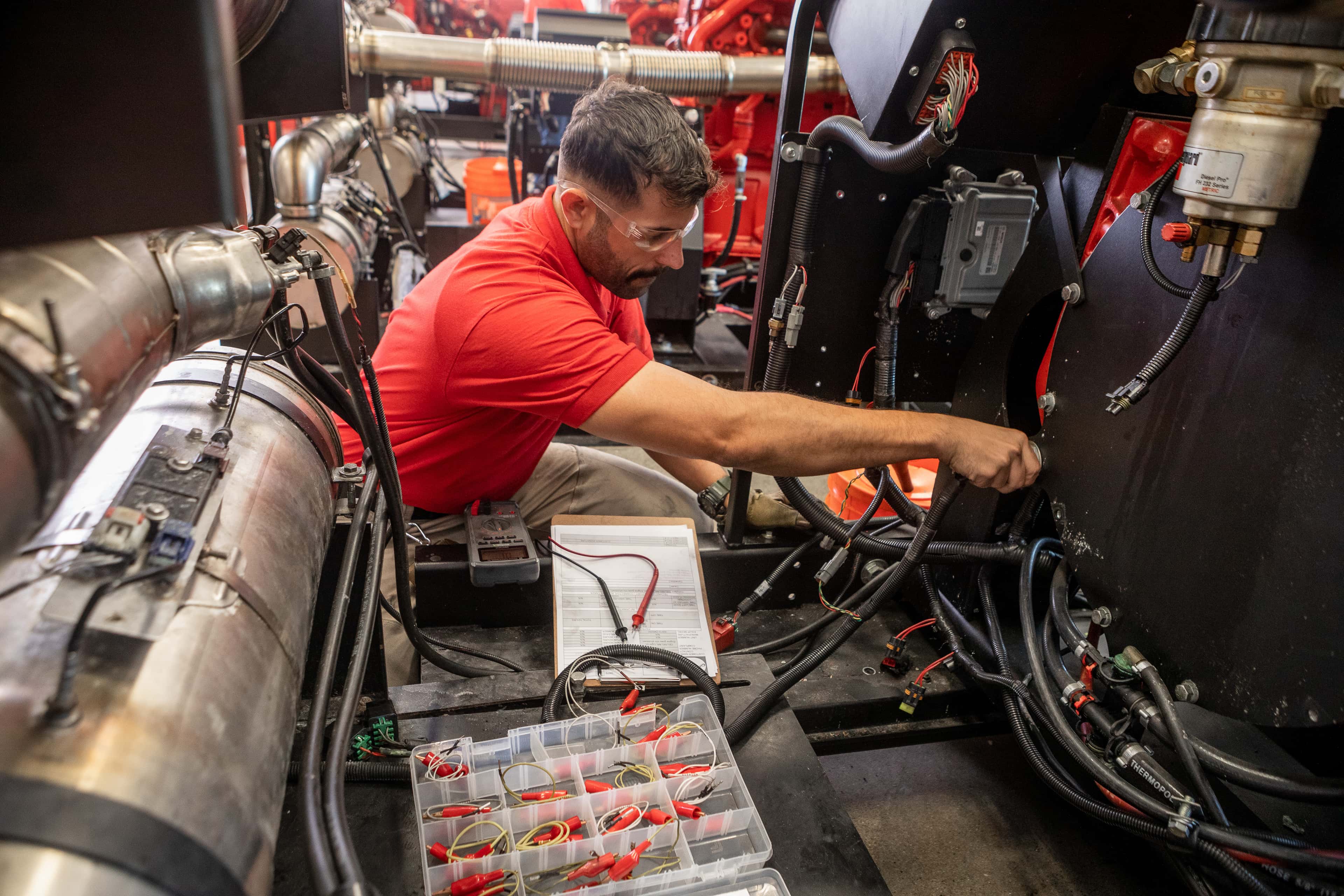Diesel Engine Terminology: Essential Guide for Aspiring Mechanics
When you're starting your journey toward the world of diesel mechanics, the lingo can be as daunting as the machinery is powerful. Picture this: You're standing in a workshop, surrounded by growling engines that require what feels like a foreign language to understand. Your initial response might be worry, but it doesn’t have to be.
In this guide, we’ll define common diesel engine terms and how to become proficient at using them. From understanding what diesel fuel is to explaining sophisticated engine systems, we’ve got you covered!
What is Diesel Engine Terminology and Why Does It Matter?
Diesel engine terminology is the language used to explain diesel engines and the wider industry.
Whether you’re a young enthusiast or a mature career shifter, a strong foundation in diesel terminology matters. It's necessary for effective communication with coworkers and customers, and professional growth.
For the aspiring diesel mechanic, a strong command of industry terms may be the difference between excelling and feeling discouraged.
Common Diesel Engine Terminology
To make it easier, we'll categorize important diesel engine terms into fuel, accessories, components, systems, performance and technology.
Diesel Fuel
Diesel fuel is a combustible liquid that powers diesel engines.
- Petrodiesel: Derived from crude oil petroleum, this is the fuel that’s powered diesel engines for decades.
- Biodiesel: A renewable biofuel manufactured from natural sources like vegetable oils, animal fats or recycled grease. It's a petrodiesel alternative that can reduce emissions.
- Cetane: A colorless hydrocarbon in petroleum that ignites under a small amount of heat. In the world of diesel, cetane is a number that measures how easy it is for fuel to ignite. Higher cetane numbers mean easier ignition and combustion, resulting in smoother engine operation and lower emissions.
- Lowest Additive Concentration (LAC): The minimum number of detergent additives in diesel fuel as mandated by the Environmental Protection Agency. Keeping the LAC helps maintain fuel efficiency.
Diesel Engine Accessories
Accessories improve operation and power delivery to help an engine perform at its peak capacity. Diesel engine terms associated with accessories include:
- Turbochargers: Devices that boost engine power by forcing more air into the combustion chamber. The extra air allows the engine to burn more fuel, increasing horsepower.
- Intercoolers: A component that cools down the air compressed by the turbocharger before it enters the combustion chamber. This process improves engine efficiency by increasing the air density.
- Programmer: An electronic device used to modify parameters like fuel-to-air ratio and ignition timing, offering the ability to customize engine performance.
- Water methanol injector: Injects a mixture of water and methanol into the air intake of an engine to cool it during the combustion process, reduce engine knock, and increase power and efficiency.
- Class V Hitch: The highest class of hitches available. It is designed for towing large loads and can handle gross trailer weights of up to 20,000 pounds, making it ideal for commercial and industrial applications.
Diesel Engine Components
Diesel engine components facilitate mechanical operation.
- Cylinder block: Thepart of the engine that houses the cylinders and their related components, including cylinder walls, cylinder sleeves and coolant passages.
- Cylinders: The space within the cylinder block where the pistons move up and down to compress and ignite fuel.
- Cylinderhead: Seals the top of the engine cylinders to control air and fuel flow. It also houses the fuel injectors and valves and is the topmost part of the combustion chamber.
- Head gasket: The seal between the engine block and the cylinder head. It contains the combustion gases within the cylinders while preventing coolant or engine oil from leaking into them.
- Piston: A component that moves up and down inside the cylinder and converts combustion energy into mechanical force at the crankshaft.
- Connecting rods: Connect the pistons to the crankshaft, transferring the force from the pistons to the crankshaft.
- Crankshaft: A long metal shaft that converts the pistons’ up-and-down movement into rotational movement for the wheels.
- Flywheel: A heavy spinning disc at the bottom of the crankshaft that stores rotational energy to keep the engine running smoothly.
- Intake manifold: Where the air-fuel mixture gets distributed to the engine cylinders. It also manages airflow, playing a key role in optimizing engine performance and fuel efficiency.
- Intake valves: Valves that open to let the air-fuel mixture into the cylinder for combustion.
- Exhaust manifold: Collects exhaust gas from the cylinders and funnels them into one pipe. This process helps guide the gases safely out of the vehicle, aiding in performance and emissions control.
- Exhaust valves: Valves that open to let out the exhaust gases created during combustion.
- Camshafts: Shafts with lobes that open and close the intake and exhaust valves at the appropriate time.
- Fuel injector: Sprays atomized fuel into the chamber at the right time for combustion.
- Fuel filter: A component that removes impurities from diesel fuel before it reaches the fuel injector.
- Fuel pump: A device that pumps fuel from the tank to the fuel injector.
- Fuel lines: The hoses that carry the fuel from the tank to the injector.
- Fuel pressure regulator: Maintains constant fuel pressure in the engine and adjusts it accordingly.
- Exhaust gas recirculation (EGR) valve: A component that recirculates a portion of exhaust gas back to the engine cylinders. It helps reduce nitrogen oxide emissions and improve engine efficiency.
- Timing belt: Synchronizes the rotation of the crankshaft and camshafts to ensure proper timing between the valves and pistons.
- Glow plugs: Pre-heat the air and fuel in the combustion chamber to aid in cold-starting.
- Governor: A mechanical device that regulates the fuel supply to maintain consistent engine speed, regardless of load changes.
- Compressor: Compresses intake air in a turbocharger before it enters the cylinders for increased power output.
- Compressor inducer: Where air enters the turbocharger, usually at the center of the compressor wheel.
- Compressor exducer: Where air exits the turbocharger, usually found at the outer edge of the compressor wheel.
Diesel Engine Systems
Diesel engine systems are complex and work in harmony to optimize engine efficiency. Diesel engine terms related to systems are:
- Cooling system: Regulates engine temperature to prevent overheating, usually composed of a radiator or heat exchanger, coolant, water pump and thermostat.
- Lubrication system: Ensures all moving parts are lubricated to reduce friction and prevent damage. It typically involves an oil pump, filter and oil pan.
- Exhaust system: Transports exhaust gases from the engine to the vehicle's rear to reduce emissions and noise. Components typically include the exhaust manifold, valves, catalytic converter and muffler.
- Fuel system: Stores and delivers fuel to the engine for combustion. It includes a fuel tank, injectors, pump, lines and regulator.
- Common-rail fuel injection system: An electronically controlled system that supplies fuel to injectors from a high-pressure rail. It allows precise control for improved engine performance and reduced emissions.
- Air intake system: Directs air into the engine for combustion, filtering it to remove contaminants. Key components often include the air filter, throttle body and mass airflow sensor.
- Accessory drive: Transfers power from the engine to supporting components like the alternator, power steering pump and air conditioning compressor. It typically involves belts and pulleys.
Diesel Engine Performance
Diesel engine performance refers to metrics and indicators that assess power and efficiency. Common diesel terminology surrounding performance includes:
- Horsepower: Measures engine power output. In practical terms, it's how fast a vehicle can go.
- Torque: The twisting force produced by a diesel engine to get the vehicle moving from a stop and pull heavy loads.
- Thermal efficiency: Measures how effectively an engine converts heat from fuel into energy. The higher it is, the less wasted energy there is.
- Compression ratio: Compares the cylinders' volume at the bottom of the piston stroke to the volume at the top. Higher ratios mean greater fuel efficiency and power.
- Displacement: The total volume of all the engine cylinders. A larger displacement rating usually means more power but less fuel efficiency.
- Transient response time: The time it takes for a turbocharged engine to deliver full power from a low speed or idle.
- Drive pressure: The pressure in the exhaust manifold of a turbocharged engine. Lower drive pressure can improve turbo efficiency and power output.
- Turbo lag: The delay between when you step on the gas and when the turbocharger delivers full power.
Diesel Technology
Today’s engines rely on advanced diesel technology to operate more efficiently.
- Diesel oxidation catalysts (DOC): Devices that convert harmful gases in the exhaust system into less harmful substances using a catalyst. They're crucial for reducing emissions.
- Selective catalyst reduction systems (SCR): An emission control system that injects a liquid reductant agent into the exhaust stream. This results in cleaner emissions made of nitrogen and water vapor.
- Diesel particulate filter (DPF): Removes particulate matter from the exhaust gas of a diesel engine. It helps reduce the amount of soot and other particles that diesel engines release into the atmosphere.
- Engine Control Module (ECM): Manages engine functions like fuel mixture, ignition timing and variable valve timing to optimize performance.
Other Diesel Engine Terms
- 2-stroke diesel engine: An engine that uses two piston movements to complete one power cycle. This design offers high power output for its size but is not as fuel-efficient as a 4-stroke engine.
- 4-stroke diesel engine: An engine that completes a power cycle in four piston strokes: intake, compression, combustion and exhaust. It's more complex but delivers better fuel efficiency and smoother operation than a 2-stroke engine.
How To Learn Diesel Mechanic Terminology
At first, learning diesel engine terminology may seem challenging, but as you build your vocabulary, you'll find yourself interpreting and explaining information more easily. Here are some strategies to help you become fluent in the language of diesel:
- Immerse yourself: Read technical manuals and industry publications to see these terms used in context.
- Online resources: From glossaries to forums, there’s an abundance of online resources dedicated to diesel terminology.
- Fieldwork and shadowing: When possible, spend time in real-world diesel environments to witness these items and concepts in action.
- Formal training:Educational programs for diesel mechanics, like the one at Universal Technical Institute (UTI), offer comprehensive instruction in terminology. This instruction can also help you become prepared for a career as a diesel technician.1
FAQs
What Is Diesel Slang?
Slang refers to informal language used by people of a specific trade or group. Mechanics often create and use slang terms to rapidly share information, including phrases like “rolling coal” or “dual fuelers.” Learning slang will come with time in the field.
What Is the Term for a Diesel Engine?
Internal combustion engine is another term for the diesel engine. This is because air and fuel mix inside a diesel engine, causing spontaneous combustion that translates to mechanical energy.
What Are Diesel Engine Brands I Should Know?
Common diesel engine brands you might hear about are Cummins,46Detroit Diesel, Duramax and Caterpillar. UTI has relationships with some of these, allowing diesel mechanic students to get specialized diesel training on their equipment.
Become Fluent in Diesel Engine Terminology at UTI
Mastering diesel terminology is not just a side quest. It's the objective of a diesel mechanic's story. Knowing diesel engine terms helps mechanics fix engines more efficiently and make valuable contributions to the field.
Learn about diesel terminology and mechanics at Universal Technical Institute (UTI), a leading provider of career training in Diesel Technology. UTI’s diesel classes simulate real-world conditions to prepare students interested in going into the field. Through hands-on, industry-specific training, students can become fluent in the language of diesel engines.18 Ready to get started?
Campuses That Offer Diesel Mechanic Training
Universal Technical Institute of Illinois, Inc. is approved by the Division of Private Business and Vocational Schools of the Illinois Board of Higher Education.

